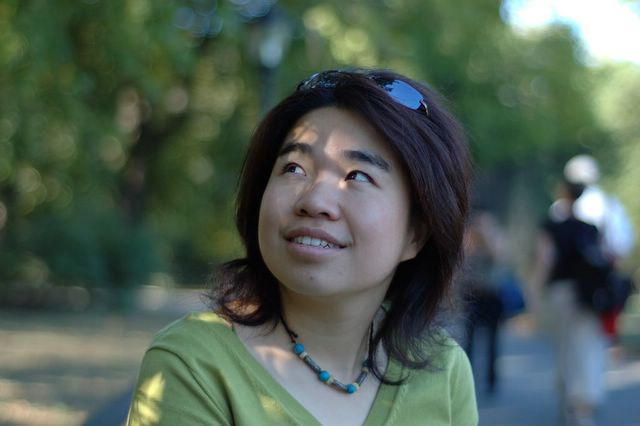 一个人开始谈论成长的问题,开始回忆过去,一方面意味着她已经变老,另一个方面也许意味着新的开始。因为她发现过去的门已经渐渐远去。 今晚和几个大学的同学吃饭,我们有五年没有见了。研究生毕业之后,我们三个到了美国,另一个留在国内工作。她刚刚从普华跳槽到中金,正在纽约接受培训。真是机缘巧合,我和她的同事同乘一架飞机从洛杉矶返回纽约,一路聊天,居然发现有共同的朋友。今天吃饭的时候,发现大家外形都没什么变化,但是个人的经历已经是千差万别。我从她们的身上看到自己另外的可能性,并不感到惊讶,只是感叹每个人的人生只有一次选择的机会。
下午的时候在大都会美术馆消磨,有两个非常有意思的展览。本来是去看蔡国强的作品,发现搞错了时间。但是碰到了Samuel Palmer (1805–1881)的展览,一个非常有意思的英国艺术家.他对于英国的乡村有一种难以言传的眷恋,他笔下的牧羊人总是在沉睡之中,仿佛沉浸于对于历史的追忆里.另一个展览是关于埃及新王朝时期第十八王朝的女王, Hatshepsut: From Queen to Pharaoh. 以下是对于她的介绍:
"Hatshepsut (Hat-shep-soot), the first important female ruler known to history, lived a thousand years after the pyramids were built and seventeen centuries after the Egyptians had begun writing their language in hieroglyphs. She ruled Egypt for two decades (ca. 1473–1458 B.C.) during Egypt's Dynasty 18. Although less familiar to modern audiences than her much later successor, the notorious Cleopatra (51–30 B.C.), Hatshepsut's achievements were far more significant. Ruling first as regent for, then as co-ruler with, her nephew Thutmose III (who ruled for another 33 years after her death), Hatshepsut enjoyed a relatively peaceful reign, at the beginning of the New Kingdom. During this time, she restored monuments destroyed during the disruptive Second Intermediate Period, when northern Egypt was controlled by a dynasty of Asian princes and southern Egypt by a dynasty of Egyptians based in Thebes. She renewed trade with western Asia to the east, the far-off land of Punt to the south, and the Aegean Islands to the north. The resulting economic prosperity was reflected in the art of the time, which is characterized by remarkable innovations in sculpture and decorative arts and produced such architectural marvels as Hatshepsut's mortuary temple at Deir el-Bahri. "
由于继任的统治者对她的不满,她的寺庙和塑像在她逝世20年后遭到了拆毁和埋没.但也正是因为如此,它们免遭历史的破坏,完整的保存了下来.直到1903年左右,才被考古学者挖掘出来.历史学家从被篡改的历史文本中逐渐复原了Hatshepsut的形象,发现了她的历史地位和贡献.然而历史毕竟是由男人书写的,所以现在还有许多关于她的身世的谜团没有解开.也许正因为如此,她才格外的迷人和神秘.
一个人开始谈论成长的问题,开始回忆过去,一方面意味着她已经变老,另一个方面也许意味着新的开始。因为她发现过去的门已经渐渐远去。 今晚和几个大学的同学吃饭,我们有五年没有见了。研究生毕业之后,我们三个到了美国,另一个留在国内工作。她刚刚从普华跳槽到中金,正在纽约接受培训。真是机缘巧合,我和她的同事同乘一架飞机从洛杉矶返回纽约,一路聊天,居然发现有共同的朋友。今天吃饭的时候,发现大家外形都没什么变化,但是个人的经历已经是千差万别。我从她们的身上看到自己另外的可能性,并不感到惊讶,只是感叹每个人的人生只有一次选择的机会。
下午的时候在大都会美术馆消磨,有两个非常有意思的展览。本来是去看蔡国强的作品,发现搞错了时间。但是碰到了Samuel Palmer (1805–1881)的展览,一个非常有意思的英国艺术家.他对于英国的乡村有一种难以言传的眷恋,他笔下的牧羊人总是在沉睡之中,仿佛沉浸于对于历史的追忆里.另一个展览是关于埃及新王朝时期第十八王朝的女王, Hatshepsut: From Queen to Pharaoh. 以下是对于她的介绍:
"Hatshepsut (Hat-shep-soot), the first important female ruler known to history, lived a thousand years after the pyramids were built and seventeen centuries after the Egyptians had begun writing their language in hieroglyphs. She ruled Egypt for two decades (ca. 1473–1458 B.C.) during Egypt's Dynasty 18. Although less familiar to modern audiences than her much later successor, the notorious Cleopatra (51–30 B.C.), Hatshepsut's achievements were far more significant. Ruling first as regent for, then as co-ruler with, her nephew Thutmose III (who ruled for another 33 years after her death), Hatshepsut enjoyed a relatively peaceful reign, at the beginning of the New Kingdom. During this time, she restored monuments destroyed during the disruptive Second Intermediate Period, when northern Egypt was controlled by a dynasty of Asian princes and southern Egypt by a dynasty of Egyptians based in Thebes. She renewed trade with western Asia to the east, the far-off land of Punt to the south, and the Aegean Islands to the north. The resulting economic prosperity was reflected in the art of the time, which is characterized by remarkable innovations in sculpture and decorative arts and produced such architectural marvels as Hatshepsut's mortuary temple at Deir el-Bahri. "
由于继任的统治者对她的不满,她的寺庙和塑像在她逝世20年后遭到了拆毁和埋没.但也正是因为如此,它们免遭历史的破坏,完整的保存了下来.直到1903年左右,才被考古学者挖掘出来.历史学家从被篡改的历史文本中逐渐复原了Hatshepsut的形象,发现了她的历史地位和贡献.然而历史毕竟是由男人书写的,所以现在还有许多关于她的身世的谜团没有解开.也许正因为如此,她才格外的迷人和神秘.
2006年5月6日星期六
怀念成长岁月
 一个人开始谈论成长的问题,开始回忆过去,一方面意味着她已经变老,另一个方面也许意味着新的开始。因为她发现过去的门已经渐渐远去。 今晚和几个大学的同学吃饭,我们有五年没有见了。研究生毕业之后,我们三个到了美国,另一个留在国内工作。她刚刚从普华跳槽到中金,正在纽约接受培训。真是机缘巧合,我和她的同事同乘一架飞机从洛杉矶返回纽约,一路聊天,居然发现有共同的朋友。今天吃饭的时候,发现大家外形都没什么变化,但是个人的经历已经是千差万别。我从她们的身上看到自己另外的可能性,并不感到惊讶,只是感叹每个人的人生只有一次选择的机会。
下午的时候在大都会美术馆消磨,有两个非常有意思的展览。本来是去看蔡国强的作品,发现搞错了时间。但是碰到了Samuel Palmer (1805–1881)的展览,一个非常有意思的英国艺术家.他对于英国的乡村有一种难以言传的眷恋,他笔下的牧羊人总是在沉睡之中,仿佛沉浸于对于历史的追忆里.另一个展览是关于埃及新王朝时期第十八王朝的女王, Hatshepsut: From Queen to Pharaoh. 以下是对于她的介绍:
"Hatshepsut (Hat-shep-soot), the first important female ruler known to history, lived a thousand years after the pyramids were built and seventeen centuries after the Egyptians had begun writing their language in hieroglyphs. She ruled Egypt for two decades (ca. 1473–1458 B.C.) during Egypt's Dynasty 18. Although less familiar to modern audiences than her much later successor, the notorious Cleopatra (51–30 B.C.), Hatshepsut's achievements were far more significant. Ruling first as regent for, then as co-ruler with, her nephew Thutmose III (who ruled for another 33 years after her death), Hatshepsut enjoyed a relatively peaceful reign, at the beginning of the New Kingdom. During this time, she restored monuments destroyed during the disruptive Second Intermediate Period, when northern Egypt was controlled by a dynasty of Asian princes and southern Egypt by a dynasty of Egyptians based in Thebes. She renewed trade with western Asia to the east, the far-off land of Punt to the south, and the Aegean Islands to the north. The resulting economic prosperity was reflected in the art of the time, which is characterized by remarkable innovations in sculpture and decorative arts and produced such architectural marvels as Hatshepsut's mortuary temple at Deir el-Bahri. "
由于继任的统治者对她的不满,她的寺庙和塑像在她逝世20年后遭到了拆毁和埋没.但也正是因为如此,它们免遭历史的破坏,完整的保存了下来.直到1903年左右,才被考古学者挖掘出来.历史学家从被篡改的历史文本中逐渐复原了Hatshepsut的形象,发现了她的历史地位和贡献.然而历史毕竟是由男人书写的,所以现在还有许多关于她的身世的谜团没有解开.也许正因为如此,她才格外的迷人和神秘.
一个人开始谈论成长的问题,开始回忆过去,一方面意味着她已经变老,另一个方面也许意味着新的开始。因为她发现过去的门已经渐渐远去。 今晚和几个大学的同学吃饭,我们有五年没有见了。研究生毕业之后,我们三个到了美国,另一个留在国内工作。她刚刚从普华跳槽到中金,正在纽约接受培训。真是机缘巧合,我和她的同事同乘一架飞机从洛杉矶返回纽约,一路聊天,居然发现有共同的朋友。今天吃饭的时候,发现大家外形都没什么变化,但是个人的经历已经是千差万别。我从她们的身上看到自己另外的可能性,并不感到惊讶,只是感叹每个人的人生只有一次选择的机会。
下午的时候在大都会美术馆消磨,有两个非常有意思的展览。本来是去看蔡国强的作品,发现搞错了时间。但是碰到了Samuel Palmer (1805–1881)的展览,一个非常有意思的英国艺术家.他对于英国的乡村有一种难以言传的眷恋,他笔下的牧羊人总是在沉睡之中,仿佛沉浸于对于历史的追忆里.另一个展览是关于埃及新王朝时期第十八王朝的女王, Hatshepsut: From Queen to Pharaoh. 以下是对于她的介绍:
"Hatshepsut (Hat-shep-soot), the first important female ruler known to history, lived a thousand years after the pyramids were built and seventeen centuries after the Egyptians had begun writing their language in hieroglyphs. She ruled Egypt for two decades (ca. 1473–1458 B.C.) during Egypt's Dynasty 18. Although less familiar to modern audiences than her much later successor, the notorious Cleopatra (51–30 B.C.), Hatshepsut's achievements were far more significant. Ruling first as regent for, then as co-ruler with, her nephew Thutmose III (who ruled for another 33 years after her death), Hatshepsut enjoyed a relatively peaceful reign, at the beginning of the New Kingdom. During this time, she restored monuments destroyed during the disruptive Second Intermediate Period, when northern Egypt was controlled by a dynasty of Asian princes and southern Egypt by a dynasty of Egyptians based in Thebes. She renewed trade with western Asia to the east, the far-off land of Punt to the south, and the Aegean Islands to the north. The resulting economic prosperity was reflected in the art of the time, which is characterized by remarkable innovations in sculpture and decorative arts and produced such architectural marvels as Hatshepsut's mortuary temple at Deir el-Bahri. "
由于继任的统治者对她的不满,她的寺庙和塑像在她逝世20年后遭到了拆毁和埋没.但也正是因为如此,它们免遭历史的破坏,完整的保存了下来.直到1903年左右,才被考古学者挖掘出来.历史学家从被篡改的历史文本中逐渐复原了Hatshepsut的形象,发现了她的历史地位和贡献.然而历史毕竟是由男人书写的,所以现在还有许多关于她的身世的谜团没有解开.也许正因为如此,她才格外的迷人和神秘.
订阅:
博文评论 (Atom)


没有评论:
发表评论